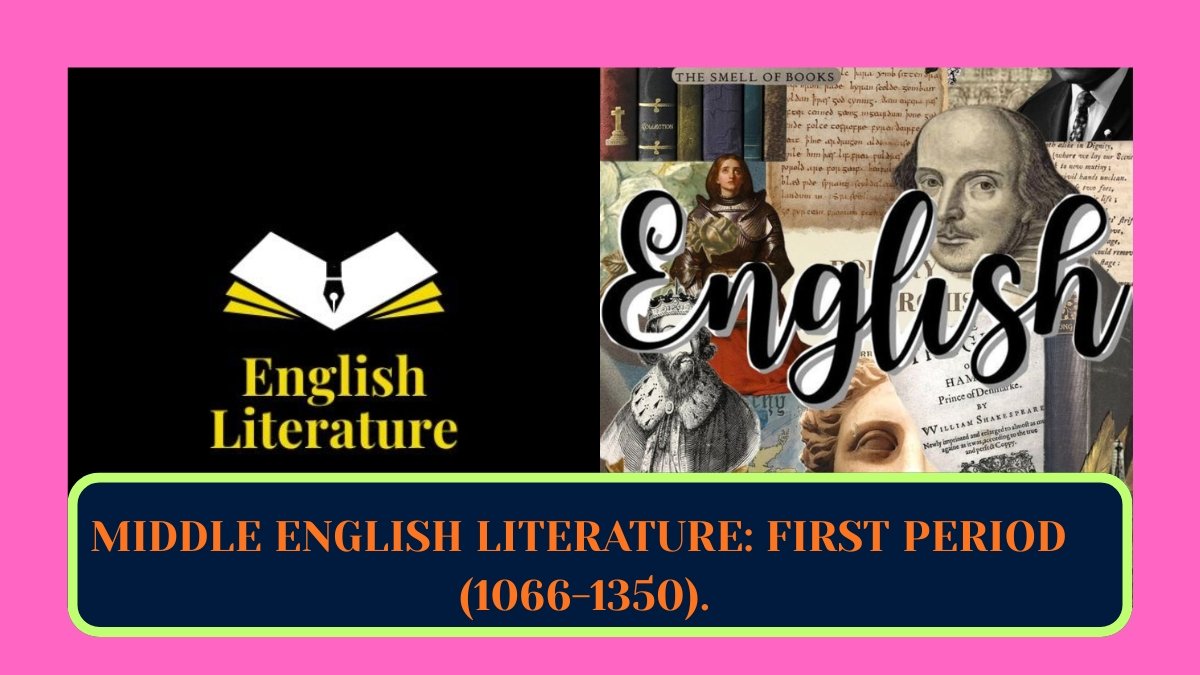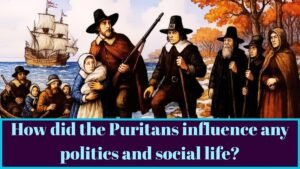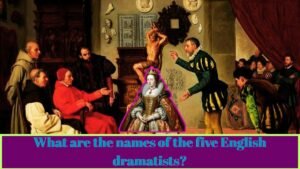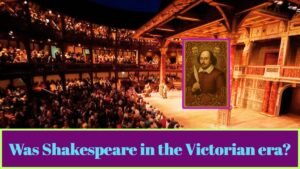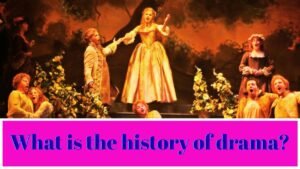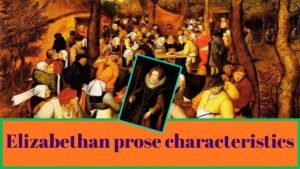MIDDLE ENGLISH LITERATURE: FIRST PERIOD (1066-1350).
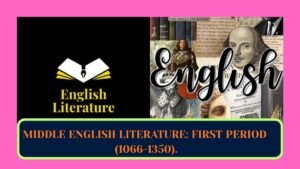
ENGLISH LITERATURE:Middle English transitional between old and modern English-Revival of English language The influence of Frenech romantic literature-Lay-amon’s Brut introducing King Arthur-Ormulum, Ancren Rewle. The Owl and the Nightingale-Handlying Sin, Cursor Mundi, The Prick of Conscience -Sir Gawayn and the Green Kinght-Lyrics
What is English Literature?
The first period of Middle English literature, like Anglo-Saxon literature, can interest only the advanced or specialist student. So a very brief account of it is all that is necessary for the student of modern English literature which really begins with Chaucer who belongs to the second period of Middle English. Middle English is the name given to the transition period during which old English was changing into modern English. This period lasted roughly 350 years from the Norman Conquest to the end of the fourteenth century.
The literature of the first Middle English period of three centuries has little intrinsic worth, but is historically important in view of the part it played in the evolution of modern English literature. The first 150 years are a blank as nothing noteworthy was produced till the beginning of the thirteenth century. There may be several reasons. Maybe the conquest had stunned English literature into silence, or the limitations of the Anglo-Saxon ianguage prevented it from further advance. Besides, the Normans at the conquest had no literature to offer in its place. French literature was in its infancy at the Conquest, but during the twelfth and thirteenth centuries it developed rapidly into the dominant literature of Europe. Whatever the reason for the dearth of literature during the eleventh and twelfth cen centuries, the fact remains that when English literature revived at the beginning of the thirteenth century, it looked to French models and not to Anglo-Saxon. And for a very good reason. The French literature which the Normans now brought to England and was gay and colourful in spirit, soft in vocabulary, and musical in its rhymed verse. As opposed to this, the Anglo-Saxon literature was cheerless and humourless in spirit, hard in vocabulary and monotonous in its alliterative doggrel. It is true that it had more thought and feeling, the ‘high seriousness’ demanded by Matthew Arnold, but too much of it can be suffocating and there is no denying the fact that Anglo-Saxon poetry is on the whole depressing. French literature, on the other hand, was bright, romantic and entertain-ing. Whatever the relative merits of the two literatures, the English were captivated by the romantic literature of France which turned the stream of English literature into entirely different channels. France was at the time the cultural centre of Europe, and it is not surprising that the English, a defeated race smarting under a sense of inferiority, copied French models. The position was analogous to that of India under British rule, when Indians adopted not only English ways, but also English literary models in their vernacular writings-a process which is still continuing and which has contributed not a little to the enrichment of Indian literature.
This revival of English literature began in the reign of King John, by which time the two races had begun to mix freely. We have seen how the English and the Normans combined to force John to sign the Magna Carta. The loss of John’s French possessions tended further to cement the bonds of unity between the English and the French. English, so far a despised tongue, came to the fore and in course of time replaced French. With English attain-ing the dignity of a written language, English literature too revived. The first noteworthy work produced under French influence is Layamons’ Brut written about 1205. This voluminous poem of about 30,000 lines is a legendary history of Britain named after Brut or Brutus, the grandson of Aeneas, one of the heroes of Troy. Brutus is the supposed founder of Britain and of new Troy or London. Layamon brings his account down to Cadwallader, the last of Celtic kings. This work is a translation from French, but what makes it interesting is that it introduces for the first time the story of King Arthur. It also contains among other things the story of king Lear and the last part of Comus. More interesting still is Layamon’s versification which is a blending of the old and the new. He has not abandoned the Anglo-Saxon alliterative system altogether but now and then stumbles upon rhyme. A little later appeared Orm’s Ormulum, a verse paraphrase of the Church gospels. This though rhymeless goes further in adopting the French regularity in the number of syllables. Moreover, these syllables form iambic feet. A little later came a prose treatise, the Ancren Riwle or the Rule of Anchoresses, containing rules for the guidance of three Anchoresses or ladies who had taken to religious life, but were not strictly governed by the discipline of nuns. The number of French words in it suggests a French original and its prose style is a great advance over the Anglo-Saxon. The most interesting of all the early productions, however, is The Owl and the Nightingale, averse debate between the two birds about their relative merits. It has dropped the Anglo-Saxon alliteration altogether and is written in the rhyming octosyllabic couplets of the French. prose
All the above mentioned works were produced during the first quarter of the thirteenth century. The rest of the century is a blank. The principal productions of the first half of the fourteenth century may be considered briefly under three heads: Religious, Romance and Lyric.
Religious: Of the three important religious works, all in verse,
one Robert Mannying’s, Handlying Sin (Handbook of sins) is a translation from the French and contains stories or fables about various sins. The other verse work is Cursor Mundi (the course of the world), a huge poem in octosyllabic couplets giving the whole story of the Bible together with the lives of the saints, all enriched by the imagination of the anonymous author. The third, The Prick of Conscience by Richard Rolle of Hampole, a remarkable hermit, is in octosyllabic couplets sprinkled with decasyllabic lines and describes in detail the horrifying tortures of hell.
Romance: The most important branch of English literature culti-
vated during this period and for long afterwards was romance. Stories of love and chivalry were very popular in France, the most popular being Chansons de geste or songs of heroic deeds, that centred round Charlemagne and his Knights. These became popular in England and led to the production of a great number of romances dealing with heroes of France, Rome, Britain (Celtic) and England. The most interesting of those produced during the first half of the fourteenth century is Sir Gawayn and the Green Knight. The Green Knight appears before King Arthur and the Knights of his Round Table and challenges anyone to strike him a blow on the condition that he will submit to a return blow from the Green Knight after a year at the Green Chapel. Sir Gawayn gives the blow and cuts off his head, at which, to the amazement of all, the Green Knight calmly picks up the head and marches off. A year after on his way to the Green Chapel, Sir Gawayn stays at a castle and is lavishly entertained by his host. He is visited by the host’s wife who tempts him. But he resists her except taking a few kisses and a magic girdle which makes its wearer invulnerable. According to a bargain with the host that they will exchange whatever they gain by hunting or other means, he returns the kisses, but keeps the girdle in view of the awful appointment with the Green Knight, who, it is needless to say, is the host himself who had planned the temptation. For his steadfastness in resisting the main temptation, the Green Knight saves Gawayne’s life, inflicting only a slight wound for his concealment of the girdle gird of invulnerability.
This poem is Anglo-Saxon in its alliterative verse and vocabulary, but is remarkable not only for its story interest but also for its powerful descriptions and touches of humour, dealing with Charle-magne. Besides the Arthurian circle, there were hundreds of other romances, most of them translations or adaptations from French originals dealing with French, English, classical, and even oriental subjects.
Lyric: The third department of literature that was opened to English was the Lyric. Love is an important motive in lyric and this was absent in Anglo-Saxon poetry. Moreover, lyric being subjective or personal demands variety of metre of which Anglo-Saxon was incapable These were now supplied by French ex-amples which led to the production of a large number of charming lyrics in England. A few of these have found a place in antholo-gies. Specimens that follow are the Cuckoo Song and Alison, a love song.
For word-meanings the reader is referred to The Oxford Book of English Verse.
Cuckoo Song
SUMER is icumen in, Lhude sing cuccu! Groweth sed (seed), and bloweth med (meadow), And springeth the wude nu (wood new)-Sing cuccu!
Awe bleteth after lomb, Lhouth after calve cu (ewe); Bulluc sterteth, bucke verteth (loveth), Murie sing cuccu!
Cuckoo, cuckoo, well sings you, cuckoo: Do not swike you naver; Sing cuckoo, nu, sing cuckoo, Sing cuckoo, sing cuckoo, nu!
Alison
BYTUENE Mershe and Averil When spray biginneth to springe, The lutel foul hath hire wyl On hyre lud to synge: Ich libbe in love-longinge For semlokest of alle thynge, He may me blisse bringe, Ich am in hire baundoun. An hendy hap inchabbe y-hent, Ichot from hevene it is me sent, From alle wymmen my love is le..t And lyht on Alysoun.
On heu hire her is fayr ynoh, With lossum chere he on me loh; With middel smal and wel y-make; Bote he me wolle to hire take For to buen hire owen make, Long to lyven ichulle forsake And feye fallen adoun. Hire browe broune, hire eye blake; An hendy hap, etc.
Nihtes when I wende and wake, For-thi myn wonges waxethon, Levedi, al for thine sake Longinge is y-lent me on. In world nis non so, wyter mon
That al hire bounte telle con; Hire swyre is whittore than the swon, And feyrest may in toune. An hendy hap, etc.
Ich am for wowyng al for-wake, Wery so water is wore; Lest eny reve me my make Ichabbe y-yerned yore. Betere is tholien whyle sore Then mournen evermore. Geynest under gore, Herkne to my roun. An hendy hap, etc.
